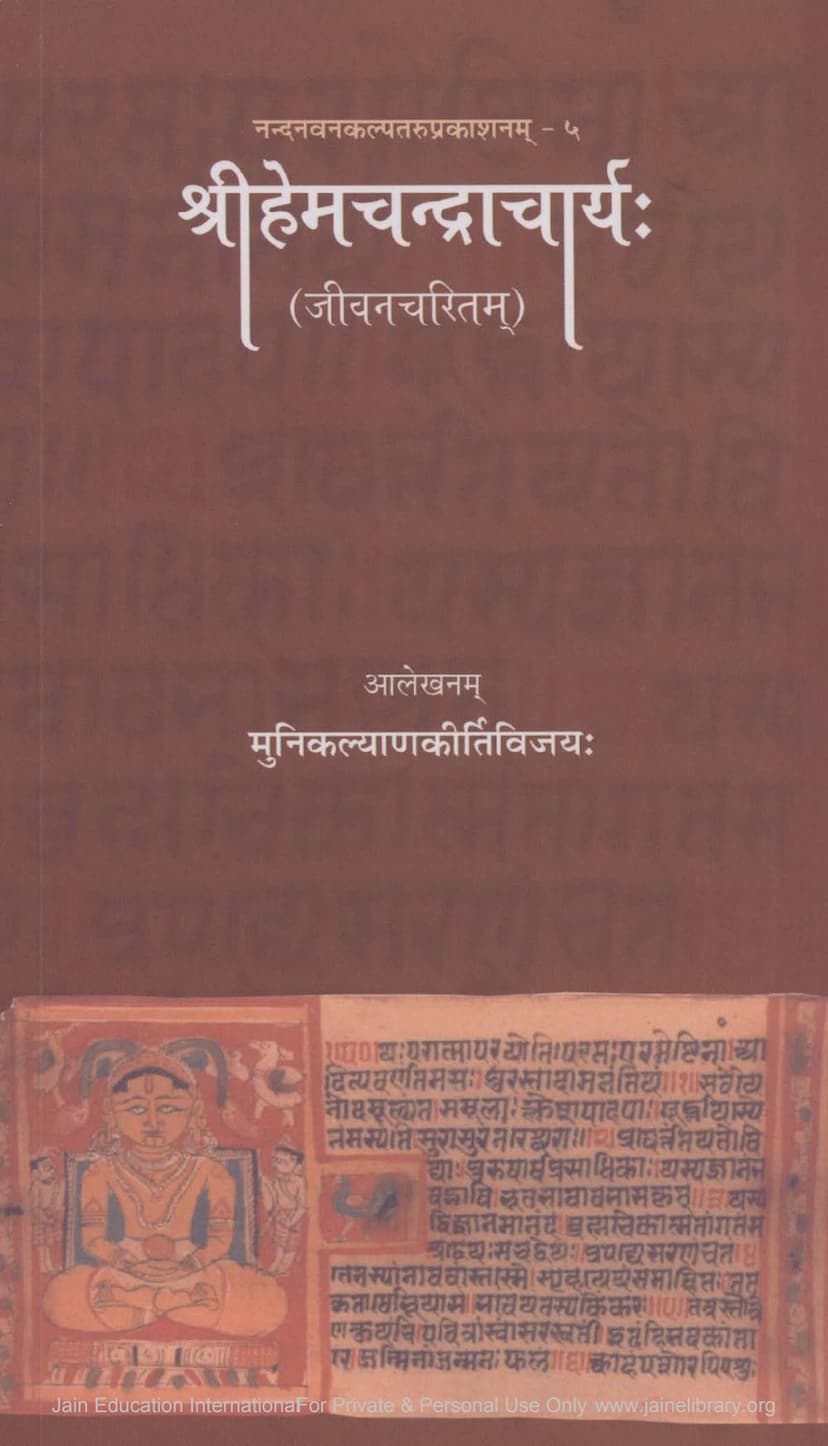Hemchandracharya Jivan Charitam
Added to library: September 1, 2025

Summary
Here is a comprehensive summary in English of the Jain text "Hemchandracharya Jivan Charitam" by Kalyankirtivijay, based on the provided pages:
This document is the fifth publication in the "Nandanvan Kalpataru Prakashan" series, dedicated to the life and works of Acharya Hemachandra, renowned as the "Kālikālasarvajña" (Omniscient of the Kali Age). The book, authored by Muni Kalyankirtivijay and published by Shri Bhadrankaroday Shikshan Trust, Godhra, aims to introduce the world to the extraordinary virtues, scholarship, and genius of Acharya Hemachandra.
The text begins by establishing the immense and unparalleled personality of Acharya Hemachandra, who is presented as a synthesis of the greatest minds and poets of ancient India like Panini, Mammata, Anandavardhana, Amarasingha, Kalidasa, Akshapada, Patanjali, and Vyasa. It highlights his significant contribution to enriching Gujarati language, literature, and culture, calling him a "living asceticism."
The book then delves into the historical and geographical context, focusing on Gurjaradesha (modern Gujarat). It paints a picture of the industrious, courageous, and peace-loving nature of its people, tracing their historical prowess in maritime trade and cultural exchange across the globe. The text emphasizes the deep-rooted influence of Jainism and its propagators in shaping the region's cultural and spiritual landscape. It highlights how Jain monks, migrating from the east due to persecution and natural calamities, found refuge and flourished in Gujarat, profoundly influencing its people with their principles of non-violence, compassion, and ethical living.
The narrative then meticulously traces the lineage of Jain Acharyas, leading up to Hemachandra's immediate predecessors. A significant portion details the life of Acharya Devachandra, Hemachandra's maternal uncle and guru, and the circumstances surrounding the birth and early life of Changa Deva, who would later be initiated as Muni Somachandra, and eventually become Acharya Hemachandra. The auspicious signs at his birth and his extraordinary intellect are emphasized.
A substantial part of the text is dedicated to the reign of King Siddharaja Jayasingha of the Chalukya dynasty and his interactions with Acharya Hemachandra. The King, a scholar and a seeker of knowledge and harmony among religions, was deeply impressed by Hemachandra's wisdom, erudition, and balanced perspective. Their relationship is depicted as a unique confluence of political power and spiritual guidance, where Hemachandra's counsel influenced Siddharaja's policies and his intellectual pursuits. The text recounts debates Hemachandra engaged in, his scholarly contributions to the royal court, and his role in advising the king on matters of governance and philosophy.
The narrative then shifts to the reign of King Kumarpala, Siddharaja's successor. Kumarpala, initially not a follower of Jainism, is gradually drawn to Hemachandra's teachings. The book details how Hemachandra guided Kumarpala towards adopting the principles of Jainism, particularly emphasizing non-violence (ahimsa), vegetarianism, and the cessation of animal sacrifice. Kumarpala's reign is portrayed as a golden era for Gujarat, marked by peace, prosperity, and the flourishing of arts and sciences, largely attributed to Hemachandra's guidance. The king's significant acts of piety, such as the renovation of the Somnath temple (following Jain principles of non-violence in worship) and the establishment of numerous Jain temples and institutions, are highlighted.
The text also discusses Hemachandra's extensive literary contributions, detailing his major works such as:
- Siddha-Hema Shabdanushasana (Siddha-Hema Vyakarana): A comprehensive grammar of Sanskrit and Prakrit (including Apabhramsa), considered a monumental achievement in linguistic scholarship.
- Dvyashraya Mahakavya: An epic poem that serves as an illustration for his grammar, narrating the history of the Chalukya dynasty and the principles of Prakrit language.
- Kavya Anushasana: A treatise on poetics and rhetoric.
- Chhandanushasana: A work on prosody.
- Abhidhana Chintamani: A thesaurus.
- Deshi Nama Mala: A lexicon of vernacular words.
- Yoga Shastra: A treatise on Yoga, written for King Kumarpala.
- Trishashti Shalaka Purusha Charitra: A vast epic detailing the lives of 63 great individuals in Jain tradition (Tirthankaras, Chakravartins, Vasudevas, etc.).
- Mahadeva Stotra: A devotional hymn to Lord Shiva, showcasing Hemachandra's inclusive approach to spiritual reverence.
- Anyayoga Vyavacheda Dwatrimshika & Yogashastra: Works exploring philosophical concepts and practices.
The book emphasizes Hemachandra's universal outlook and his ability to synthesize diverse philosophies and practices, earning him the title "Kālikālasarvajña." His teachings promoted harmony, tolerance, and the underlying unity in different religious and philosophical systems.
The text also briefly introduces Hemachandra's disciples, highlighting the significant contributions of figures like Acharya Ramachandra Suri, a prolific playwright and scholar.
Finally, the book concludes by celebrating Hemachandra's life as a testament to dedication, knowledge, spiritual discipline, and societal welfare. His passing is described as a solemn event, deeply mourned by his disciples, the king, and the populace, underscoring his profound impact on Gujarat and Indian culture. The text asserts that Hemachandra's legacy continues to inspire, embodying the ideals of wisdom, compassion, and intellectual pursuit.
The included "Parishishta" (Appendix) contains the "Mahadeva Dwatrimshika" (a hymn to Lord Shiva in 32 verses), a discussion on the "Pravrajya of the Pandavas" (narrating their renunciation and seeking spiritual liberation as described in Jain scriptures, contrasting it with the Mahabharata account), and the "Charisamjivani Char Dristanta" (an illustration of the concept that even unknowingly following a righteous path can lead to liberation). It also includes various anecdotes ("Prasangah") showcasing Hemachandra's wit, wisdom, and profound understanding.
Overall, the book "Hemachandracharya Jivan Charitam" serves as an in-depth biography and tribute to one of the most influential figures in Jain history and Indian intellectual tradition, celebrating his multifaceted contributions to religion, philosophy, literature, and the cultural enrichment of Gujarat.